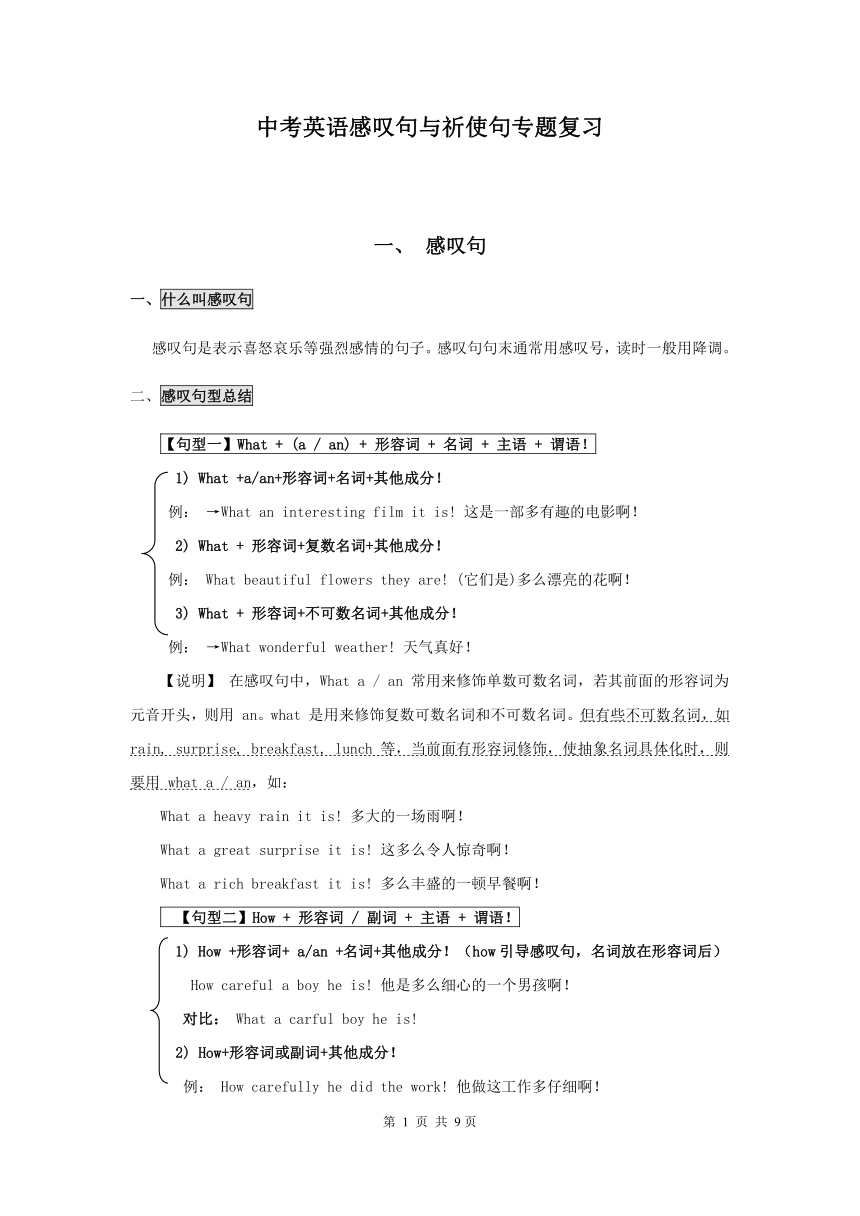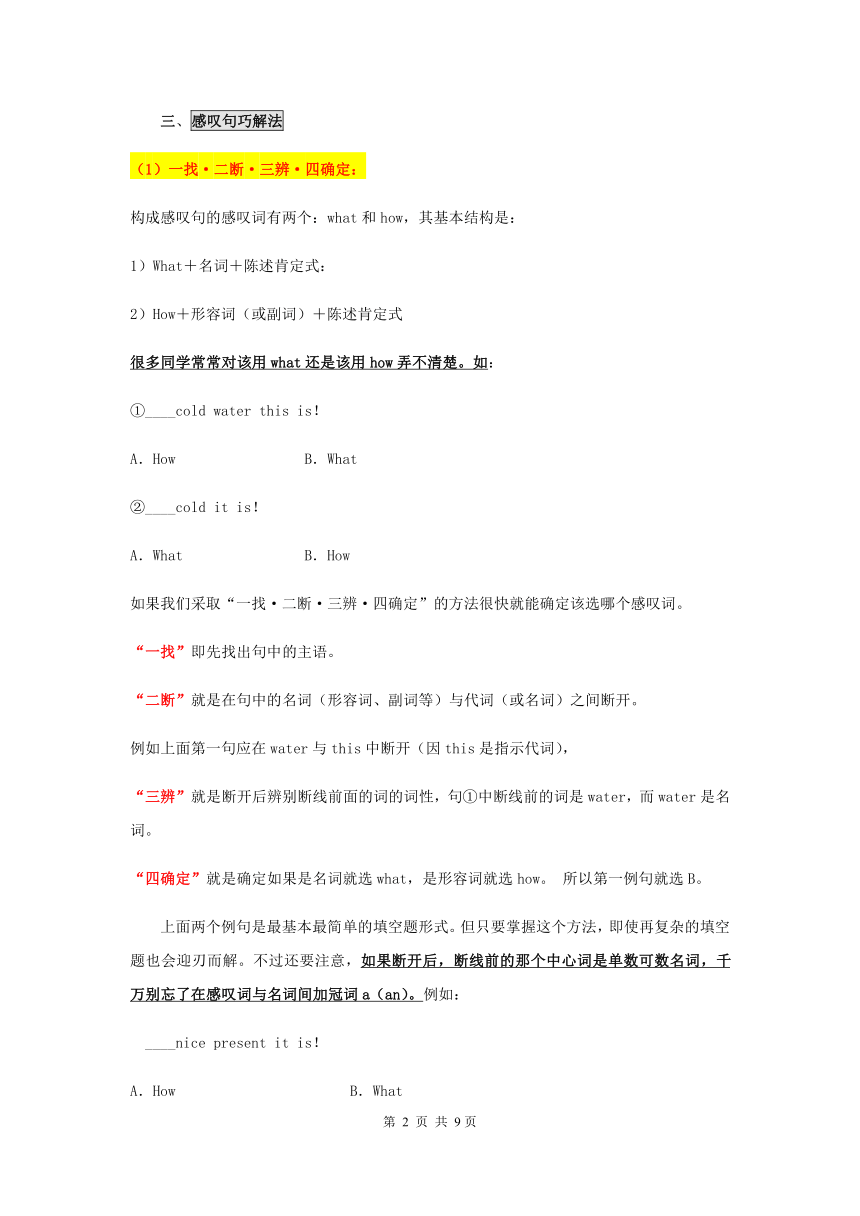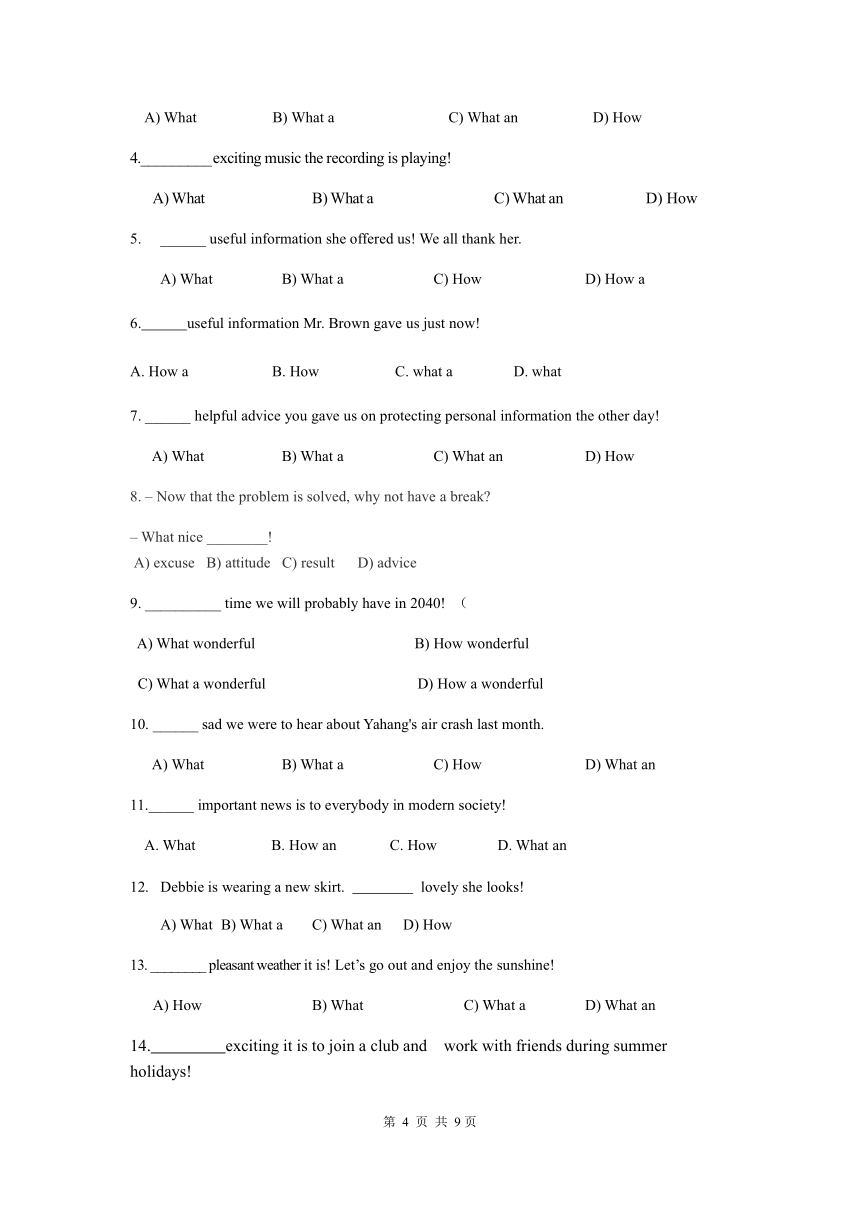中考英语感叹句与祈使句专题复习部分有答案
文档属性
| 名称 | 中考英语感叹句与祈使句专题复习部分有答案 |  | |
| 格式 | zip | ||
| 文件大小 | 34.8KB | ||
| 资源类型 | 教案 | ||
| 版本资源 | 通用版 | ||
| 科目 | 英语 | ||
| 更新时间 | 2021-01-26 15:13:50 | ||
图片预览




文档简介
中考英语感叹句与祈使句专题复习
感叹句
一、什么叫感叹句
感叹句是表示喜怒哀乐等强烈感情的句子。感叹句句末通常用感叹号,读时一般用降调。
二、感叹句型总结
【句型一】What
+
(a
/
an)
+
形容词
+
名词
+
主语
+
谓语!
1)
What
+a/an+形容词+名词+其他成分!
例:
→What
an
interesting
film
it
is!
这是一部多有趣的电影啊!
2)
What
+
形容词+复数名词+其他成分!
例:
What
beautiful
flowers
they
are!
(它们是)多么漂亮的花啊!
3)
What
+
形容词+不可数名词+其他成分!
例:
→What
wonderful
weather!
天气真好!
【说明】
在感叹句中,What
a
/
an
常用来修饰单数可数名词,若其前面的形容词为元音开头,则用
an。what
是用来修饰复数可数名词和不可数名词。但有些不可数名词,如
rain,
surprise,
breakfast,
lunch
等,当前面有形容词修饰,使抽象名词具体化时,则要用
what
a
/
an,如:
What
a
heavy
rain
it
is!
多大的一场雨啊!
What
a
great
surprise
it
is!
这多么令人惊奇啊!
What
a
rich
breakfast
it
is!
多么丰盛的一顿早餐啊!
?【句型二】How
+
形容词
/
副词
+
主语
+
谓语!
1)
How
+形容词+
a/an
+名词+其他成分!(how引导感叹句,名词放在形容词后)
How
careful
a
boy
he
is!
他是多么细心的一个男孩啊!
对比:
What
a
carful
boy
he
is!
2)
How+形容词或副词+其他成分!
例:
How
carefully
he
did
the
work!
他做这工作多仔细啊!
??三、感叹句巧解法
(1)一找·二断·三辨·四确定:
构成感叹句的感叹词有两个:what和how,其基本结构是:
1)What+名词+陈述肯定式:
2)How+形容词(或副词)+陈述肯定式
很多同学常常对该用what还是该用how弄不清楚。如:
①____cold
water
this
is!
A.How
B.What
②____cold
it
is!
A.What
B.How
如果我们采取“一找·二断·三辨·四确定”的方法很快就能确定该选哪个感叹词。
“一找”即先找出句中的主语。
“二断”就是在句中的名词(形容词、副词等)与代词(或名词)之间断开。
例如上面第一句应在water与this中断开(因this是指示代词),
“三辨”就是断开后辨别断线前面的词的词性,句①中断线前的词是water,而water是名词。
“四确定”就是确定如果是名词就选what,是形容词就选how。
所以第一例句就选B。
上面两个例句是最基本最简单的填空题形式。但只要掌握这个方法,即使再复杂的填空题也会迎刃而解。不过还要注意,如果断开后,断线前的那个中心词是单数可数名词,千万别忘了在感叹词与名词间加冠词a(an)。例如:
____nice
present
it
is!
A.How
B.What
C.How
D.What
a
用上述方法,从present与it之间断开,断线前present是名词,且为单数可数名词,nice又以辅音开头,故选D。
(2)“断→找→去→添→改”五步法:
若把一个陈述句变为感叹句,可以采取这“五步法”。如:
The
picture
is
very
beautiful.
断:在陈述句中的谓语动词后将句子断开:
The
picture
is|very
beautiful.
找:划出断线后的中心词是何词类。
去:中心词是形容词或副词时,要把修饰该形容词或副词的词去掉。(比如本句中心词beautiful是形容词,修饰该词的是very,变时应去掉very。但须注意,线后如果是名词,名词前的修饰语是万万不能去掉的。
添:就是添上感叹词。如果线后的中心词是名词,就添What;是形容词或副词就添How。
改:将陈述句句前的大写改为小写,将变为感叹句的感叹词及其修饰的名词部分放在句首,感叹词首写字母改为大写。同时句尾的标点由陈述句的句号改为感叹句的感叹号。
据此,上句就变成了:How
beautiful
the
picture
is!
感叹句专项练习
一.单选题
1.
warm
and
rainy
weather
it
was
last
November
in
Shanghai.
A.
What
B.
What
a
C.
What
an
D.
How
2.
_____
helpless
the
poor
little
girl
is
after
she
lost
both
her
parents
in
the
car
accident!
A)
How
B)
What
C)
What
a
D)
What
an
3.
exciting
program
Tint
Running
Man
is!
A)
What
B)
What
a
C)
What
an
D)
How
4.
exciting
music
the
recording
is
playing!
A)
What
B)
What
a
C)
What
an
D)
How
5.
______
useful
information
she
offered
us!
We
all
thank
her.
A)
What
B)
What
a
C)
How
D)
How
a
6.
useful
information
Mr.
Brown
gave
us
just
now!
A.
How
a
B.
How
C.
what
a
D.
what
7.
______
helpful
advice
you
gave
us
on
protecting
personal
information
the
other
day!
A)
What
B)
What
a
C)
What
an
D)
How
8.
–
Now
that
the
problem
is
solved,
why
not
have
a
break?
–
What
nice
________!??
?A)
excuse???B)
attitude???C)
result
????D)
advice
9.
__________
time
we
will
probably
have
in
2040!
(
A)
What
wonderful
B)
How
wonderful
C)
What
a
wonderful
D)
How
a
wonderful
10.
______
sad
we
were
to
hear
about
Yahang's
air
crash
last
month.
A)
What
B)
What
a
C)
How
D)
What
an
11.______
important
news
is
to
everybody
in
modern
society!
A.
What
B.
How
an
C.
How
D.
What
an
12.
Debbie
is
wearing
a
new
skirt.
lovely
she
looks!
A)
What
B)
What
a
C)
What
an
D)
How
13.
________
pleasant
weather
it
is!
Let’s
go
out
and
enjoy
the
sunshine!
A)
How
B)
What
C)
What
a
D)
What
an
14.
exciting
it
is
to
join
a
club
and
work
with
friends
during
summer
holidays!
A)
How
B)
How
an
C)
What
D)
What
an
15.
_
_
nice
film
Wolf
Totem
(狼图腾)
is!
I'd
like
to
see
it
again
if
l
am
free.
A)
How
B)
What
an
C)
What
D)What
a
16.
________
enjoyable
the
journey
was!
We
really
had
a
great
time.
A)
What
B)
What
a
C)
What
an
D)
How
二、句型转换
17.
Shanghai
International
Art
Festival
brought
us
many
wonderful
performances.(改为感叹句)
_______
_______
performances
Shanghai
International
Art
Festival
brought
us
!
18.Lind
has
a
pretty
wooden
horse.
(改为感叹句)
?____________
____________
pretty
wooden
horse
Linda
has!
19.
We
have
fine
weather
today.
(改为感叹句)
________________________weather
we
have
today!
20.
My
pen
friend
has
sent
me
a
very
beautiful
birthday
card.(改为感叹句)
_________
_________
beautiful
birthday
card
my
pen
friend
has
sent
me!
21.
It’s
fun
to
have
a
barbecue
on
such
a
sunny
day.
(改为感叹句)
it
is
to
have
a
barbecue
on
such
a
sunny
day!
22.The
audience
arrived
at
the
theater
very
early.
(改为感叹句)
the
audience
arrived
at
the
theater!
23.
He
feels
so
proud
to
be
elected
chairman
of
the
Students’
Union.
(改为感叹句)
________
________
he
feels
to
be
elected
chairman
of
the
Students’
Union
祈使句
一、祈使句(Imperative
Sentence)
定义:用于表达命令、请求、劝告、警告、禁止等的句子叫做祈使句,祈使句最常用于表达命令,因此在学校文法中也常称为命令句。
祈使句因对象(即主语)是第二人称,所以通常都省略。祈使句的动词都为一般现在时,句末则使用句号来表示结束。例:
Go
and
wash
your
hands.
(去洗你的手。——命令)
Be
quiet,
please.(Please
be
quiet.)
(请安静。——请求)
Be
kind
to
our
sister.
(对姊妹要和善。——劝告)
Watch
your
steps.
(走路小心。——警告)
Look
out!Danger!
(小心!危险!——强烈警告,已如感叹句)
Keep
off
the
grass.
(勿践草坪。——禁止)
No
parking.
(禁止停车。——禁止)
祈使句也常把主语“You”表达出来,使对方听起来觉得柔和些,例如:
You
go
and
tell
him,
Chris.
(克立斯你去告诉他。)
二、相关口令
祈使句无主语, 主语you常省去;
动词原形谓语当, 句首加don't否定变;
朗读应当用降调, 句末常标感叹号。
三、表现形式
●肯定结构:
1.
Do型(即:动词原形(+宾语)+其它成分)。如:Please
have
a
seat
here.
请这边坐。
有的祈使句在意思明确的情况下,动词可省略。如:This
way,
please.
=
Go
this
way,
please.
请这边走。
2.
Be型(即:Be
+
表语(名词或形容词)+其它成分)。如:Be
a
good
boy!
要做一个好孩子!
3.
Let型(即:Let
+
宾语
+
动词原形
+
其它成分)。如:Let
me
help
you.
让我来帮你。
●否定结构:
1.
Do型和Be型的否定式都是在句首加don't构成。如:Don't
forget
me!
不要忘记我!
Don't
be
late
for
school!
上学不要迟到!
2.
Let型的否定式有两种:“Don't
+
let
+
宾语
+
动词原形
+
其它成分”和“Let
+
宾语
+
not
+
动词原形
+
其它成分”。如:Don't
let
him
go.
/
Let
him
not
go.
别让他走。
3.
有些可用no开头,用来表示禁止性的祈使句。如:No
smoking!
禁止吸烟!No
fishing!
禁止钓鱼!
祈使句的反义疑问句:
省去主语的祈使句的反意疑问句,疑问部分用will
you。
Don’t
do
that
again,
will
you?
Go
with
me,
will
you?
Let’s
开头的祈使句,反义疑问句用:shall
we?
Let’s
go
and
listen
to
the
music,
shall
we?
Let
us开头的祈使句,反义疑问句用:will
you?
Let
us
wait
for
you
in
the
reading-room,
will
you?
祈使句专项练习
单选题
1.
The
TV
is
too
loud.
Please________.
A.
turn
it
down
B.
to
turn
it
down
C.
turn
down
it
D.
to
turn
down
it
2.
_______
late
again,
Bill!
A.
Don't
to
be
B.
Don't
be
C.
Not
be
D.
Be
not
3.
_______
cross
the
road
until
the
traffic
lights
turn
green.
A.
Not
B.
Won't
C.
Doesn't
D.
Don't
4.
Please
help
me
carry
it,
______?
A.
will
I
B.
will
you
C.
shall
I
D.
shall
we
5.
Don't
make
so
much
noise,
______?
A.
will
you
B.
won't
you
C.
shall
we
D.
do
you
6.
Do
you
know
the
girl
______under
the
tree?
A.
stand
B.
to
stand
C.
standing
D.
stood
7.
Kate,
_______
your
homework
here
tomorrow.
A.
bring
B.
brings
C.
to
bring
D.
bringing
8.
________
me
the
truth,
or
I'll
be
angry.
A.
Telling
B.
To
tell
C.
Told
D.
Tell
9.
I've
kept
the
dog
_______Maomao
for
a
long
time.
A.
Name
B.
named
C.
naming
D.
to
name
10.
Don't
you
know
that
_______
is
good
for
our
health?
A.
swim
B.
swimming
C.
swam
D.
swims?
句型转换
11.
Will
you
please
read
it
again
more
slowly?
(改为祈使句)
_____
_____
again
more
slowly,
please.
12.
If
you
don't
listen
to
me,
I'll
go.
(改为同义句)
_____
_____
me,
or
I’ll
go.
13.
Let's
watch
the
sports
games.
(改为反意疑问句)
Let's
watch
the
sports
games,
_____
_____?
14.
The
teachers
often
tell
the
students
not
to
be
careless.
(改为祈使句)
_____
_____careless,
please.
15.
Please
sit
next
to
Nancy.
(改为否定句)
_____
_____
next
to
Nancy.
16.
Don't
forget
to
turn
off
the
lights,
please.
(改为反意疑问句)
Don't
forget
to
turn
off
the
lights,
_____
_____?
17.
If
you
move,
you'll
die.
(改为同义句)
_____
_____,
or
you'll
die.
e
to
my
house
tomorrow.
(改为反意疑问句)
Come
to
my
house
tomorrow,
_____
_____?
19.
这是一个坏了的被子。
(翻译句子)
This
is
a
______
______.
20.
让我们去帮帮那个哭泣的女孩吧。
(翻译句子)
Let’s
go
and
help
the
_____
_____,
please.??
参考答案:
1-5.
ABDBA
6-10.
CADBB
11.
Read
it
12.
Listen
to
13.
shall
we
14.
Don’t
be
15.
Don’t
sit
16.
will
you
17.
Don’t
move
18.
will
/
won’t
you
19.
broken
glass
/
cup
20.
crying
girl
感叹句
一、什么叫感叹句
感叹句是表示喜怒哀乐等强烈感情的句子。感叹句句末通常用感叹号,读时一般用降调。
二、感叹句型总结
【句型一】What
+
(a
/
an)
+
形容词
+
名词
+
主语
+
谓语!
1)
What
+a/an+形容词+名词+其他成分!
例:
→What
an
interesting
film
it
is!
这是一部多有趣的电影啊!
2)
What
+
形容词+复数名词+其他成分!
例:
What
beautiful
flowers
they
are!
(它们是)多么漂亮的花啊!
3)
What
+
形容词+不可数名词+其他成分!
例:
→What
wonderful
weather!
天气真好!
【说明】
在感叹句中,What
a
/
an
常用来修饰单数可数名词,若其前面的形容词为元音开头,则用
an。what
是用来修饰复数可数名词和不可数名词。但有些不可数名词,如
rain,
surprise,
breakfast,
lunch
等,当前面有形容词修饰,使抽象名词具体化时,则要用
what
a
/
an,如:
What
a
heavy
rain
it
is!
多大的一场雨啊!
What
a
great
surprise
it
is!
这多么令人惊奇啊!
What
a
rich
breakfast
it
is!
多么丰盛的一顿早餐啊!
?【句型二】How
+
形容词
/
副词
+
主语
+
谓语!
1)
How
+形容词+
a/an
+名词+其他成分!(how引导感叹句,名词放在形容词后)
How
careful
a
boy
he
is!
他是多么细心的一个男孩啊!
对比:
What
a
carful
boy
he
is!
2)
How+形容词或副词+其他成分!
例:
How
carefully
he
did
the
work!
他做这工作多仔细啊!
??三、感叹句巧解法
(1)一找·二断·三辨·四确定:
构成感叹句的感叹词有两个:what和how,其基本结构是:
1)What+名词+陈述肯定式:
2)How+形容词(或副词)+陈述肯定式
很多同学常常对该用what还是该用how弄不清楚。如:
①____cold
water
this
is!
A.How
B.What
②____cold
it
is!
A.What
B.How
如果我们采取“一找·二断·三辨·四确定”的方法很快就能确定该选哪个感叹词。
“一找”即先找出句中的主语。
“二断”就是在句中的名词(形容词、副词等)与代词(或名词)之间断开。
例如上面第一句应在water与this中断开(因this是指示代词),
“三辨”就是断开后辨别断线前面的词的词性,句①中断线前的词是water,而water是名词。
“四确定”就是确定如果是名词就选what,是形容词就选how。
所以第一例句就选B。
上面两个例句是最基本最简单的填空题形式。但只要掌握这个方法,即使再复杂的填空题也会迎刃而解。不过还要注意,如果断开后,断线前的那个中心词是单数可数名词,千万别忘了在感叹词与名词间加冠词a(an)。例如:
____nice
present
it
is!
A.How
B.What
C.How
D.What
a
用上述方法,从present与it之间断开,断线前present是名词,且为单数可数名词,nice又以辅音开头,故选D。
(2)“断→找→去→添→改”五步法:
若把一个陈述句变为感叹句,可以采取这“五步法”。如:
The
picture
is
very
beautiful.
断:在陈述句中的谓语动词后将句子断开:
The
picture
is|very
beautiful.
找:划出断线后的中心词是何词类。
去:中心词是形容词或副词时,要把修饰该形容词或副词的词去掉。(比如本句中心词beautiful是形容词,修饰该词的是very,变时应去掉very。但须注意,线后如果是名词,名词前的修饰语是万万不能去掉的。
添:就是添上感叹词。如果线后的中心词是名词,就添What;是形容词或副词就添How。
改:将陈述句句前的大写改为小写,将变为感叹句的感叹词及其修饰的名词部分放在句首,感叹词首写字母改为大写。同时句尾的标点由陈述句的句号改为感叹句的感叹号。
据此,上句就变成了:How
beautiful
the
picture
is!
感叹句专项练习
一.单选题
1.
warm
and
rainy
weather
it
was
last
November
in
Shanghai.
A.
What
B.
What
a
C.
What
an
D.
How
2.
_____
helpless
the
poor
little
girl
is
after
she
lost
both
her
parents
in
the
car
accident!
A)
How
B)
What
C)
What
a
D)
What
an
3.
exciting
program
Tint
Running
Man
is!
A)
What
B)
What
a
C)
What
an
D)
How
4.
exciting
music
the
recording
is
playing!
A)
What
B)
What
a
C)
What
an
D)
How
5.
______
useful
information
she
offered
us!
We
all
thank
her.
A)
What
B)
What
a
C)
How
D)
How
a
6.
useful
information
Mr.
Brown
gave
us
just
now!
A.
How
a
B.
How
C.
what
a
D.
what
7.
______
helpful
advice
you
gave
us
on
protecting
personal
information
the
other
day!
A)
What
B)
What
a
C)
What
an
D)
How
8.
–
Now
that
the
problem
is
solved,
why
not
have
a
break?
–
What
nice
________!??
?A)
excuse???B)
attitude???C)
result
????D)
advice
9.
__________
time
we
will
probably
have
in
2040!
(
A)
What
wonderful
B)
How
wonderful
C)
What
a
wonderful
D)
How
a
wonderful
10.
______
sad
we
were
to
hear
about
Yahang's
air
crash
last
month.
A)
What
B)
What
a
C)
How
D)
What
an
11.______
important
news
is
to
everybody
in
modern
society!
A.
What
B.
How
an
C.
How
D.
What
an
12.
Debbie
is
wearing
a
new
skirt.
lovely
she
looks!
A)
What
B)
What
a
C)
What
an
D)
How
13.
________
pleasant
weather
it
is!
Let’s
go
out
and
enjoy
the
sunshine!
A)
How
B)
What
C)
What
a
D)
What
an
14.
exciting
it
is
to
join
a
club
and
work
with
friends
during
summer
holidays!
A)
How
B)
How
an
C)
What
D)
What
an
15.
_
_
nice
film
Wolf
Totem
(狼图腾)
is!
I'd
like
to
see
it
again
if
l
am
free.
A)
How
B)
What
an
C)
What
D)What
a
16.
________
enjoyable
the
journey
was!
We
really
had
a
great
time.
A)
What
B)
What
a
C)
What
an
D)
How
二、句型转换
17.
Shanghai
International
Art
Festival
brought
us
many
wonderful
performances.(改为感叹句)
_______
_______
performances
Shanghai
International
Art
Festival
brought
us
!
18.Lind
has
a
pretty
wooden
horse.
(改为感叹句)
?____________
____________
pretty
wooden
horse
Linda
has!
19.
We
have
fine
weather
today.
(改为感叹句)
________________________weather
we
have
today!
20.
My
pen
friend
has
sent
me
a
very
beautiful
birthday
card.(改为感叹句)
_________
_________
beautiful
birthday
card
my
pen
friend
has
sent
me!
21.
It’s
fun
to
have
a
barbecue
on
such
a
sunny
day.
(改为感叹句)
it
is
to
have
a
barbecue
on
such
a
sunny
day!
22.The
audience
arrived
at
the
theater
very
early.
(改为感叹句)
the
audience
arrived
at
the
theater!
23.
He
feels
so
proud
to
be
elected
chairman
of
the
Students’
Union.
(改为感叹句)
________
________
he
feels
to
be
elected
chairman
of
the
Students’
Union
祈使句
一、祈使句(Imperative
Sentence)
定义:用于表达命令、请求、劝告、警告、禁止等的句子叫做祈使句,祈使句最常用于表达命令,因此在学校文法中也常称为命令句。
祈使句因对象(即主语)是第二人称,所以通常都省略。祈使句的动词都为一般现在时,句末则使用句号来表示结束。例:
Go
and
wash
your
hands.
(去洗你的手。——命令)
Be
quiet,
please.(Please
be
quiet.)
(请安静。——请求)
Be
kind
to
our
sister.
(对姊妹要和善。——劝告)
Watch
your
steps.
(走路小心。——警告)
Look
out!Danger!
(小心!危险!——强烈警告,已如感叹句)
Keep
off
the
grass.
(勿践草坪。——禁止)
No
parking.
(禁止停车。——禁止)
祈使句也常把主语“You”表达出来,使对方听起来觉得柔和些,例如:
You
go
and
tell
him,
Chris.
(克立斯你去告诉他。)
二、相关口令
祈使句无主语, 主语you常省去;
动词原形谓语当, 句首加don't否定变;
朗读应当用降调, 句末常标感叹号。
三、表现形式
●肯定结构:
1.
Do型(即:动词原形(+宾语)+其它成分)。如:Please
have
a
seat
here.
请这边坐。
有的祈使句在意思明确的情况下,动词可省略。如:This
way,
please.
=
Go
this
way,
please.
请这边走。
2.
Be型(即:Be
+
表语(名词或形容词)+其它成分)。如:Be
a
good
boy!
要做一个好孩子!
3.
Let型(即:Let
+
宾语
+
动词原形
+
其它成分)。如:Let
me
help
you.
让我来帮你。
●否定结构:
1.
Do型和Be型的否定式都是在句首加don't构成。如:Don't
forget
me!
不要忘记我!
Don't
be
late
for
school!
上学不要迟到!
2.
Let型的否定式有两种:“Don't
+
let
+
宾语
+
动词原形
+
其它成分”和“Let
+
宾语
+
not
+
动词原形
+
其它成分”。如:Don't
let
him
go.
/
Let
him
not
go.
别让他走。
3.
有些可用no开头,用来表示禁止性的祈使句。如:No
smoking!
禁止吸烟!No
fishing!
禁止钓鱼!
祈使句的反义疑问句:
省去主语的祈使句的反意疑问句,疑问部分用will
you。
Don’t
do
that
again,
will
you?
Go
with
me,
will
you?
Let’s
开头的祈使句,反义疑问句用:shall
we?
Let’s
go
and
listen
to
the
music,
shall
we?
Let
us开头的祈使句,反义疑问句用:will
you?
Let
us
wait
for
you
in
the
reading-room,
will
you?
祈使句专项练习
单选题
1.
The
TV
is
too
loud.
Please________.
A.
turn
it
down
B.
to
turn
it
down
C.
turn
down
it
D.
to
turn
down
it
2.
_______
late
again,
Bill!
A.
Don't
to
be
B.
Don't
be
C.
Not
be
D.
Be
not
3.
_______
cross
the
road
until
the
traffic
lights
turn
green.
A.
Not
B.
Won't
C.
Doesn't
D.
Don't
4.
Please
help
me
carry
it,
______?
A.
will
I
B.
will
you
C.
shall
I
D.
shall
we
5.
Don't
make
so
much
noise,
______?
A.
will
you
B.
won't
you
C.
shall
we
D.
do
you
6.
Do
you
know
the
girl
______under
the
tree?
A.
stand
B.
to
stand
C.
standing
D.
stood
7.
Kate,
_______
your
homework
here
tomorrow.
A.
bring
B.
brings
C.
to
bring
D.
bringing
8.
________
me
the
truth,
or
I'll
be
angry.
A.
Telling
B.
To
tell
C.
Told
D.
Tell
9.
I've
kept
the
dog
_______Maomao
for
a
long
time.
A.
Name
B.
named
C.
naming
D.
to
name
10.
Don't
you
know
that
_______
is
good
for
our
health?
A.
swim
B.
swimming
C.
swam
D.
swims?
句型转换
11.
Will
you
please
read
it
again
more
slowly?
(改为祈使句)
_____
_____
again
more
slowly,
please.
12.
If
you
don't
listen
to
me,
I'll
go.
(改为同义句)
_____
_____
me,
or
I’ll
go.
13.
Let's
watch
the
sports
games.
(改为反意疑问句)
Let's
watch
the
sports
games,
_____
_____?
14.
The
teachers
often
tell
the
students
not
to
be
careless.
(改为祈使句)
_____
_____careless,
please.
15.
Please
sit
next
to
Nancy.
(改为否定句)
_____
_____
next
to
Nancy.
16.
Don't
forget
to
turn
off
the
lights,
please.
(改为反意疑问句)
Don't
forget
to
turn
off
the
lights,
_____
_____?
17.
If
you
move,
you'll
die.
(改为同义句)
_____
_____,
or
you'll
die.
e
to
my
house
tomorrow.
(改为反意疑问句)
Come
to
my
house
tomorrow,
_____
_____?
19.
这是一个坏了的被子。
(翻译句子)
This
is
a
______
______.
20.
让我们去帮帮那个哭泣的女孩吧。
(翻译句子)
Let’s
go
and
help
the
_____
_____,
please.??
参考答案:
1-5.
ABDBA
6-10.
CADBB
11.
Read
it
12.
Listen
to
13.
shall
we
14.
Don’t
be
15.
Don’t
sit
16.
will
you
17.
Don’t
move
18.
will
/
won’t
you
19.
broken
glass
/
cup
20.
crying
girl
同课章节目录
- 词法
- 名词
- 动词和动词短语
- 动词语态
- 动词时态
- 助动词和情态动词
- 非谓语动词
- 冠词
- 代词
- 数词和量词
- 形容词副词及其比较等级
- 介词和介词短语
- 连词和感叹词
- 构词法
- 相似、相近词比较
- 句法
- 陈述句
- 一般疑问句和否定疑问句
- 特殊疑问句及选择疑问句
- 反意疑问句
- 存在句(There be句型)
- 宾语从句
- 定语从句
- 状语从句
- 主谓一致问题
- 简单句
- 并列句
- 复合句
- 主谓一致
- 主、表语从句
- 名词性从句
- 直接引语和间接引语
- 虚拟语气
- 感叹句
- 强调句
- 倒装句
- 祈使句
- 句子的成分
- 句子的分类
- 题型专区
- 单项选择部分
- 易错题
- 完形填空
- 阅读理解
- 词汇练习
- 听说训练
- 句型转换
- 补全对话
- 短文改错
- 翻译
- 书面表达
- 任务型阅读
- 语法填空
- 其他资料
